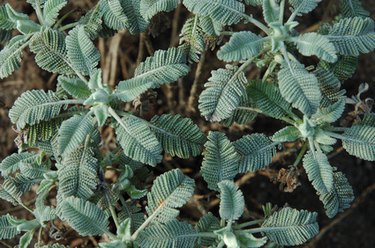
A defining characteristic of all plants, from flowering plants to cacti to trees, is the ability of their leaves to produce their own food using light from the sun. Because they can make their own food, photosynthetic organisms, like plants, are the basis of every food chain and ecosystem on the planet. Although they do not have leaves, algae and some types of bacteria can also perform photosynthesis.
Autotrophs vs. Heterotrophs
Video of the Day
Organisms that possess the ability to make their own food are known as autotrophs. These organisms have specialized cells that are able to take light from the sun and convert it into a source of energy. In addition to plants, the aquatic, plantlike organisms known as algae as well as certain types of bacteria also have this capability. Autotrophs are also known as producers.
Video of the Day
Heterotrophs, on the other hand, do not have the necessary cell components to make their own food and must therefore consume other organisms for energy. All animals, including humans, are heterotrophs, as are fungi, some bacteria and other microorganisms. Heterotrophs are also known as consumers.
Some consumers, known as herbivores, get their energy directly from plants. Carnivores, on the other hand, eat other animals, often herbivores. This transfer of energy makes up what we know as the food chain.
What Is Photosynthesis?
Photosynthesis is the process during which plants use light from the sun to produce food. Specifically, this process is a recipe for making glucose, a form of sugar that is key to plant development and survival. In addition to sunlight, plants require carbon dioxide and water in order to make glucose. Carbon dioxide enters the plant's leaves through microscopic pores known as stomata, while water is carried up through the plant's roots and stem.
The process of photosynthesis takes place inside small structures inside the cells of plant leaves known as chloroplasts. The structures contain a substance called chlorophyll. Chlorophyll absorbs red and blue light while reflecting green light, which is why plants are green. While the sun is key for photosynthesis, not all the individual reactions that make up the process require light. That is why it is said that photosynthesis involves both light-dependent and light-independent reactions.
During photosynthesis, water loses negatively charged particles known as electrons in a process known as oxidation as it turns into oxygen gas. At the same time, carbon dioxide gains electrons in a process called reduction and is converted into glucose.
The Importance of Photosynthesis
All life on Earth depends on photosynthesis in one way or another. Not only do plants themselves need the glucose they manufacture in order to grow and produce leaves, flowers, seeds and fruit but the animals who eat plants, including humans, also rely on the energy stored as glucose for survival. While the cells of plants and other photosynthetic organisms produce glucose, cells that are not photosynthetic release energy by breaking down glucose.
In addition to being a source of energy, photosynthesis releases oxygen as a waste product. Oxygen exits the leaves through the same pores, or stomata, through which carbon dioxide enters. This is another key function of photosynthesis in nature, as heterotrophs need oxygen to breathe.